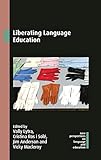Liberating Language Education / ed. by Cristina Ros í Solé, James Anderson, Vally Lytra.
Material type: TextSeries: New Perspectives on Language and Education ; 101Publisher: Bristol ; Blue Ridge Summit : Multilingual Matters, [2022]Copyright date: ©2022Description: 1 online resource (360 p.)Content type:
TextSeries: New Perspectives on Language and Education ; 101Publisher: Bristol ; Blue Ridge Summit : Multilingual Matters, [2022]Copyright date: ©2022Description: 1 online resource (360 p.)Content type: - 9781788927949
- 9781788927956
- 418.0071 23//eng/20211120eng
- online - DeGruyter
| Item type | Current library | Call number | URL | Status | Notes | Barcode | |
|---|---|---|---|---|---|---|---|
 eBook
eBook
|
Biblioteca "Angelicum" Pont. Univ. S.Tommaso d'Aquino Nuvola online | online - DeGruyter (Browse shelf(Opens below)) | Online access | Not for loan (Accesso limitato) | Accesso per gli utenti autorizzati / Access for authorized users | (dgr)9781788927956 |
Browsing Biblioteca "Angelicum" Pont. Univ. S.Tommaso d'Aquino shelves, Shelving location: Nuvola online Close shelf browser (Hides shelf browser)

|

|

|

|

|

|

|
||
| online - DeGruyter Sociocultural and Power-Relational Dimensions of Multilingual Writing : Recommendations for Deindustrializing Writing Education / | online - DeGruyter Language Education in a Changing World : Challenges and Opportunities. | online - DeGruyter Language Teacher Recognition : Narratives of Filipino English Teachers in Japan / | online - DeGruyter Liberating Language Education / | online - DeGruyter Essays on Conference Interpreting / | online - DeGruyter Translanguaging as Transformation : The Collaborative Construction of New Linguistic Realities / | online - DeGruyter Dual Language Bilingual Education : Teacher Cases and Perspectives on Large-Scale Implementation / |
Frontmatter -- Contents -- Contributors -- Introduction: Why Liberating Language Education? -- Part 1: Policies, Discourses and Ideologies -- 1 ‘I Don’t Think We Encourage the Use of their Home Language …’: Exploring ‘Multilingualism Light’ in a London Primary School -- 2 Recognising the Creole Community: Discursive Constructions of Enslavement and the Enslaved in Kreol Textbooks in Mauritius -- 3 Appropriating Portuguese Language Policies in England -- 4 Making Sense of the Internal Diversities of Greek Schools Abroad: Exploring the Purposeful Use of Translation as Communicative Resource for Language Learning and Identity Construction -- Commentary for Part 1 -- Part 2: Language-Living: Materialities, Affectivities and Becomings -- 5 Languaging in Language Cafés: Emotion Work, Creating Alternative Worlds and Metalanguaging -- 6 Language Studies as Transcultural Becoming and Participation: Undoing Language Boundaries across the Danube Region -- 7 The Textures of Language: An Autoethnography of a Gloves Collection -- Commentary for Part 2 -- Part 3: Transcultural Journeying and Aesthetics -- 8 Visual Art in Arabic Foreign and Heritage Languageand- Culture Learning: Expanding the Scope for Meaning-Making -- 9 Creating Pedagogical Spaces for Translingual and Transcultural Meaning-Making and Student Agency in a London Greek Complementary School -- 10 Opening Spaces of Learning: A Sociomaterial Investigation of Object-Based Approaches with Migrant Youth in and beyond the Heritage Language Classroom -- 11 Translanguaging Art: Exploring the Transformative Potential of Contemporary Art for Language Teaching in the Multilingual Context -- Commentary for Part 3: Liberating Language Learning through Art: The Imperative of Cultural Justice -- Part 4: Voices, Identities and Citizenship -- 12 How Weird is Weird? Young People, Activist Citizenship and Multivoiced Digital Stories -- 13 ‘Animating Objects’: Co-Creation in Digital Story Making between Planning and Play -- 14 Visual Representations of Multilingualism: Exploring Aesthetic Approaches to Communication in a Fine Art Context -- Commentary for Part 4 -- Conclusion: Language Education Collages -- Index
restricted access online access with authorization star
http://purl.org/coar/access_right/c_16ec
This book engages with new ways of understanding language that include other resources and practices and bring to the fore its messiness, unpredictability and interconnectedness. The chapters illustrate how a translingual and transcultural orientation to language can provide a point of entry to reimagining language education in the 21st century.
Mode of access: Internet via World Wide Web.
In English.
Description based on online resource; title from PDF title page (publisher's Web site, viewed 25. Jun 2024)


